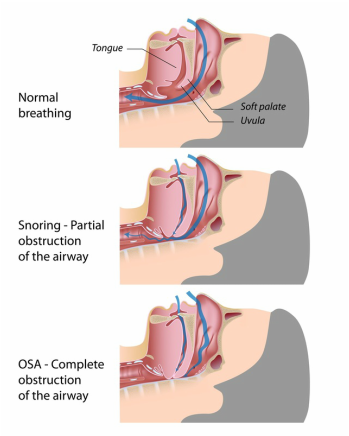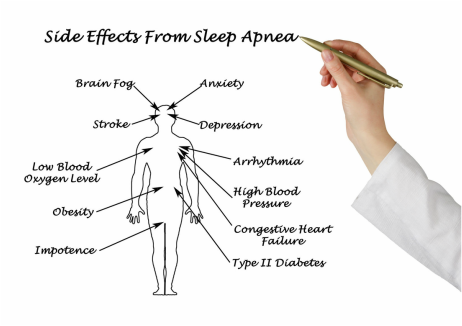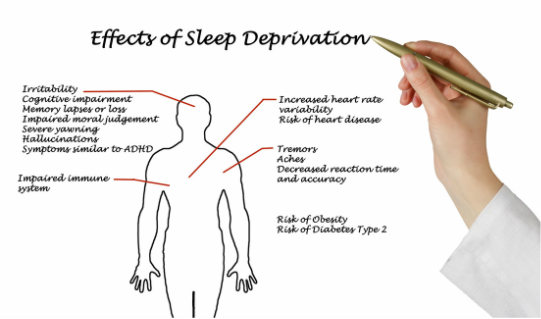Oral Appliance Therapy & NightLase® Therapy for Snoring & Obstructive Sleep Apnea

Obstructive sleep apnea (OSA) happens when there are many repeated times of complete or partial blockage of air flow at the upper airway during sleep. Patients with OSA can stop breathing as many as 20 to 30 times per hour. OSA can reduce the oxygen supply to vital organs. It also can increase the number of heart beats and can cause irregular heart rhythms. During the non-breathing periods, the diaphragm and chest muscles work harder to open the obstructed upper airway. With lack of oxygen, your brain also temporarily and briefly wakes you up to restart proper breathing. Those repeated brief wake-sleep cycles prevent patients with OSA from having deep sleep. Usually, they do not feel rested after sleep and feel drowsy during the day.
Signs & symptoms of obstructive sleep apnea may include:
Signs & symptoms of obstructive sleep apnea may include:
- Excessive daytime sleepiness
- Poor concentration
- Morning headaches
- Depression
- Night sweats
- Weight gain
- Fatigue
- Forgetfulness
- Sexual dysfunction
- Trouble falling asleep
- Teeth grinding, clenching and abfraction at the gumline
- Teeth severely eroded by stomach acid from the forceful pumping action of the diaphragm and chest muscles during the stopped breathing periods at sleep.
|
Who can get obstructive sleep apnea? Risk factors may include:
|
|
How can I find out if I have obstructive sleep apnea? Here is the screening process:
|
If you are diagnosed with sleep-disordered breathing or obstructive sleep apnea by the sleep physician, we will work with your sleep physician and primary care physician for your sleep-disordered breathing and obstructive sleep apnea treatment.
There are many treatment options for these conditions. The most common treatment options for these conditions are the Continuous Positive Air Pressure (CPAP) treatment, oral appliance therapy, and NightLase® therapy. CPAP is still the most effective treatment for OSA. However, in 2006 the American Academy of Sleep Medicine recommended that oral appliances be used as a first line treatment for mild to moderate OSA. FDA approved oral appliances used to treat OSA work by increasing oral volume, advancing the mandible and tongue and holding the mandible in a forward position. Oral appliances help to increase the free space in the back of the throat and prevent upper airway tissues from collapsing and causing an apnea event. For severe OSA, oral appliance is still a good alternative second-line treatment option if the patient cannot tolerate CPAP treatment.
There are a wide variety of custom designs for the oral appliances (conventional and ALF appliances). Each unique custom design is based on each individual patient's sleep disordered breathing condition.
There are many treatment options for these conditions. The most common treatment options for these conditions are the Continuous Positive Air Pressure (CPAP) treatment, oral appliance therapy, and NightLase® therapy. CPAP is still the most effective treatment for OSA. However, in 2006 the American Academy of Sleep Medicine recommended that oral appliances be used as a first line treatment for mild to moderate OSA. FDA approved oral appliances used to treat OSA work by increasing oral volume, advancing the mandible and tongue and holding the mandible in a forward position. Oral appliances help to increase the free space in the back of the throat and prevent upper airway tissues from collapsing and causing an apnea event. For severe OSA, oral appliance is still a good alternative second-line treatment option if the patient cannot tolerate CPAP treatment.
There are a wide variety of custom designs for the oral appliances (conventional and ALF appliances). Each unique custom design is based on each individual patient's sleep disordered breathing condition.
NightLase® therapy is a non-invasive, effective laser treatment for increasing the quality of a patient’s sleep. Nightlase uses gentle Neodymium:Yag and Erbium:Yag laser lights to non-surgically tighten and rejuvenate some enlarged or flaccid oral tissues. The laser-induced tissue tightening effect is caused by the contraction of intrinsic collagen fibers. No anesthesia is needed for this procedure. Nightlase decreases the sound of snoring and reduces the effects of sleep apnea. Nightlase is a gentle and easy way for patients and loved ones to regain good night sleep.



